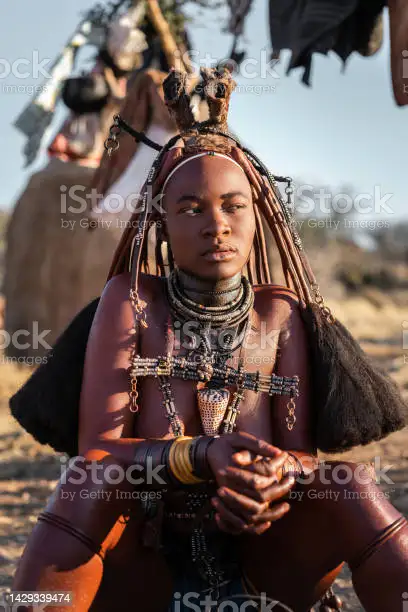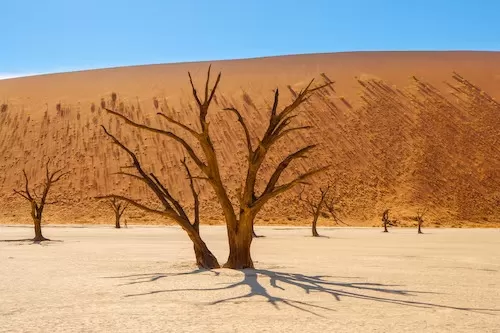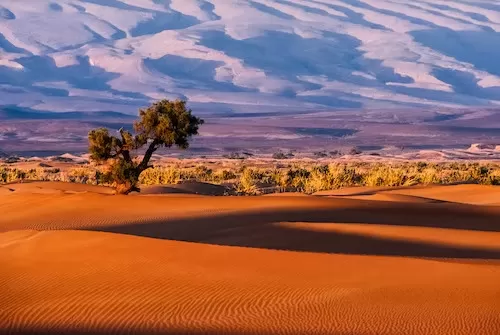The Namib Desert is one of the world’s oldest deserts which is home to giant red sand dunes, rock formations and a wild game reserve. It stretches inland from the Atlantic Ocean, covering large swathes in the Southern part of the African Continent.
What country is Namib Desert?

The Namib Dessert which can be found in the Southern part of Africa specifically almost all of Botswana, the eastern third of Namibia, and the northernmost part of Northern Cape province in South Africa is the second largest in the world after Badain Jaran Dessert dunes in China consist of sand seas near the coast, while gravel plains and scattered mountain outcrops occur further inland.
The sand dunes which some of which are about 300 metres high and also spans about 32 kilometres long. Temperatures along the coast are stable and generally range between 9 to 20 °C (48–68 °F) annually, while temperatures further inland are variable summer daytime temperatures can exceed 45 °C (113 °F) while nights can be freezing.
Fogs that originate offshore from the collision of the cold Benguela Current and warm air from the Hadley Cell create a fog belt that frequently envelops parts of the desert. Coastal regions can experience more than 180 days of thick fog a year. While this has proved a major hazard to ships more than a thousand wrecks litter the Skeleton Coast it is a vital source of moisture for desert life.
The Namib Dessert is almost completely uninhabited by humans except for several small settlements and indigenous pastoral groups, including the Ovahimba and Obatjimba Herero in the north, and the Topnaar Nama in the central region. Due to its nature, the Namib may be home to more endemic species than any other desert in the world. I
Most of the desert wildlife is arthropods and other small animals that live on little water, although larger animals inhabit the northern regions. Near the coast, the cold ocean water is rich in fishery resources and supports populations of brown fur seals and shorebirds, which serve as prey for the Skeleton Coast’s lions.

Further inland, the Namib-Naukluft National Park is specially known to be home to the largest game park in Africa, supports populations of African bush elephants, mountain zebras, and other large mammals. Although the outer Namib is largely barren of vegetation, lichens and succulents are found in coastal areas, while grasses, shrubs, and ephemeral plants thrive near the escarpment. Several types of trees are also able to survive the extremely arid climate.
Temperature in the Namib is influence by the descent of dry air of the Hadley Cell, cooled by the cold Benguela current along the coast, which has less than 10 mm (0.39 in) of rain annually and is almost completely barren. Despite the scarcity of rain in the region, it is difficult to predict rainfall in the area.
The western Namib gets less rain (5 mm) than the eastern Namib (85 mm) due to several factors. Winds coming from the Indian Ocean lose part of their humidity when passing the Drakensberg Mountains, and are essentially dry when they reach the Namib Escarpment at the eastern end of the desert.
Winds coming from the Atlantic Ocean, on the other hand, are pressed down by hot air from the east; their humidity thus forms clouds and fog. Morning fogs coming from the ocean and pushing inwards into the desert are a regular phenomenon along the coast, and much of the life cycle of animals and plants in the Namib relies on these fogs as the main source of water.
The dry climate of the Namib reflects the almost complete lack of bodies of water on the surface. Most rivers flow underground and are dry for most of the year. Even when they are not, they usually drain into endorheic basins without reaching the sea. The Swakop and the Omaruru are the only rivers that occasionally drain into the ocean.
All along the coast, but mostly in the northernmost part of it, interaction between the water-laden air coming from the sea via southerly winds, some of the strongest of any coastal desert, and the dry air of the desert causes immense fogs and strong currents.
It causes sailors to lose their way; this is testified by the remnants of a number of shipwrecks that can be found along the Skeleton Coast, in northern Namib. Some of these wrecked ships can be found as much as 50 metres (55 yards) inland, as the desert slowly moves westwards into the sea, reclaiming land over a period of many years.
Benguela’s El Niño, which is similar to the Pacific event in its environmental change in the seas, spreads from the Kunene estuary southward to, on occasion, south of Luderitz. Warm waters with depth and associated water flows from the northwest were first fully catalogued by Sea Fisheries researchers, Cape Town (L V Shannon et al.).
In the Namib, there are number of unusual species of plants and animals they canbe found of which many are endemic and highly adapted to the specific climate of the area. One of the most popular endemic plants of the Namib is the bizarre Welwitschia mirabilis, a shrub-like plant it grows two long strap-shaped leaves continuously throughout its lifetime.
These leaves may be several meters long, gnarled and twisted from the desert winds. The taproot of the plant develops into a flat, concave disc in age. Welwitschia is notable for its survival in the extremely arid conditions in the Namib, mostly deriving moisture from the coastal sea fogs. An area where Welwitschias are a common sight is found in the surroundings of the Moon Valley, including the eponymous Welwitschia Plains.
The Namib fauna mostly comprises of arthropods and other small animals that can live on little water, but a few species of bigger animals are also found, including antelopes such as gemsboks and springboks), ostriches, and in some areas even desert elephants. All these species have developed techniques to survive in the Namib environment. A number of endemic darkling beetles species such as the Namib Desert beetle, have bumpy elytrons with a pattern of hydrophilic bumps and hydrophobic troughs.
These cause humidity from the morning fogs to condense into droplets, which roll down the beetle’s back to its mouth; they are collectively known as “fog beetles”. Another beetle, the Lepidochora discoidalis, builds “water-capturing” webs. Black-backed jackals lick humidity from stones. Gemsboks (also known as the South African oryx) can raise the temperature of their bodies to 40 °C in the hottest hours of the day. The desert is also home to meerkats and several species of lizards.
Before the 20th century, some San roamed the Namib, gathering edible plants on the shore, hunting in the interior, and drinking the juice of the tsamma melon for water. In recent, some Herero still herd their livestock in the Kaokoveld in the Namib and take them from waterhole to waterhole. A few Nama Khoikhoi still graze their livestock on the banks of the Kuiseb River in the desert. Most of the native people have left, however, leaving the vast majority of the desert uninhabited.
The steppes in the southern half of the desert are mostly made up of ranches run by Europeans, who raise Karakul sheep with local help and send the pelts of the lambs to Europe for use in fur coats. Most of the rest of the desert is set aside for conservation.
A vast portion of the desert, called the Sperrgebiet, was access-restricted due to the presence of diamonds, which are mined in the area at the mouth of the Orange River. Although the desert is largely unpopulated and inaccessible, there are year-round settlements at Sesriem, close to the famous Sossusvlei area, and other small outposts in other locations. Moçâmedes in Angola, and Lüderitz, Walvis Bay and Swakopmund in Namibia, bordering on the desert, are the main settlements in the area.
In 2019 the Namibian-German artist Max Siedentopf created an installation in the Namib consisting of a ring of large white blocks atop of which sit six speakers attached to a solar-powered MP3 player configured to continuously play the 1982 song “Africa” by the American band Toto. The exact location of the installation has not been disclosed.
The Namib-Naukluft National Park that extends over a large part of the Namib Desert is the largest game reserve in Africa and one of the largest of the world. While most of the park is hardly accessible, several well-known visitor attractions are found in the desert. The prominent attraction is the famous Sossusvlei area, where high orange sand dunes surround vivid white salt pans, creating a fascinating landscape.
Access to the park is either by gravel roads or dust roads (except for 60 km of concrete road from the Sesriem gate to Sossusvlei) or by light aircraft from Windhoek (the capital of Namibia, about 480 km or 300 mi northeast of the centre of the desert) or Swakopmund and Walvis Bay at the north end of the desert.
Namibe is a Portuguese name for a cool dessert hence the name Namib.
credit: wiki
Thank you for reading this article.
Related articles
Destination Guide And Things To Do At Shai Hills Resource Reserve
Namib Africa: A Beautiful Destination To Visit
Travel Guide And Things To Do At Victoria Falls
Kenya Tourism: 16 Attractions To Explore

